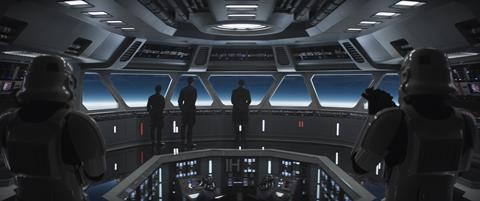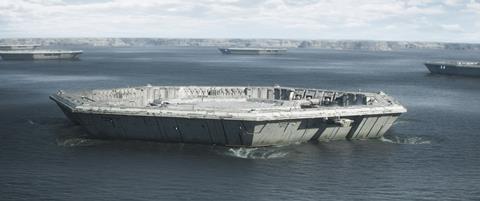Post-production uncovered: ILM on Andor (Disney+)
)
Andor arrived on Disney+ last year, and has since gone onto receive plaudits for its take on the Star Wars universe - bringing a more grounded feel than some of the films.
Andor production VFX supervisor Mohen Leo and ILM VFX supervisor Scott Pritchard worked together on fitting high-end visual effects into that world, making sure that the VFX didn’t take away from the gritty vision. The pair jointly revealed to Broadcast Tech the challenges and solutions that they came up with in the production, that has led to being nominated for the BAFTA for Special, Visual & Graphic Effects.
Which scene was the most complicated or challenging for you to work on?
The sequence from Episode 11 where Luthen Rael’s Fondor Haulcraft encounters and then disables an Imperial Arrestor Cruiser was one of the more challenging pieces of work on Andor.

What made it so challenging?
In the Star Wars universe, few scenes are as iconic and well-known as the space battles, so we all felt the weight of expectation to get this absolutely right. It had to have the thrilling dynamics of a dogfight, but also fit into the grounded aesthetics of the show.
What was your approach to this challenge and creating the VFX for this scene?
Early on in pre-production, the sequence was conceived as taking place in high orbit. A proposal was made later to set it in low orbit, enough to make use of the blue hues of the upper atmosphere. This the dual advantage of giving the sequence its own distinctive look, but also that we could make use of silhouette and negative space when blocking out the cinematography, something the blackness of space does not allow for. We also built on techniques developed by ILM for Rogue One to deliberately make the computer-generated shots look like the miniature photography of the original trilogy.

Did you use any different or new software / create innovative solutions to get round these challenges?
The challenges with this sequence were creative in nature rather than technical, so we chose to meet these challenges by paying close attention to the very fine details of the original trilogy’s miniature photography - details such as the fall off of focus when shooting the miniatures on long lenses, the particular optical characteristics of those lenses, the strong fill light contributions. Combining this with the strong spaceship and camera choreography from our animation team, we created a sequence that while an homage to the original trilogy, feels fresh, exciting and fits into the aesthetics of the overall show.
Was there any specific element of the work that was surprisingly easy or more challenging than you had first thought?
In pre-production, the original plan had been to shoot a number of sequences in international locations, but only weeks before the start of photography, the sudden covid pandemic not only delayed the shoot by a few months, but made filming abroad nearly impossible for the following year-and-a-half. As a consequence, every single shot in the season was filmed in the UK (with the exception of a few landscape plates shot in Lanzarote), forcing us to find creative solutions to depict environments on multiple planets with different climates using only UK locations.

How was it working on Andor as a whole and which scenes/ specific effects are you most proud of and why?
The close collaboration between Tony Gilroy, our production designer Luke Hull and the visual effects team made the project really rewarding to work on. Everyone pulled together to find creative solutions for the many challenges (not the least of which was shooting during a pandemic with lockdowns and restrictions), allowing us to execute ambitious sequences and create expansive new environments.

Apart from the space battle, the shipbreaking yard on Ferrix and the crash of the shuttlecraft there were particularly fun to create. The environment exemplifies our aesthetic approach to the show in general: While it has all the scope of giant spaceships and oversized structures you’d expect from Star Wars, it still feels grounded, gritty and real. Instead of postcard skies, we chose to play the scenes in overcast foggy weather, and the setting and action drew inspiration from Able Seaton Port in County Durham, where giant oil rigs are decommissioned, as well as real-world shipbreaking yards in India, Bangladesh and Africa.
How do you feel about receiving a TV BAFTA nomination for your work?
In a year where so many television projects showcased ever more ambitious feature film-level visual effects work, we feel incredibly honoured to be nominated for our work on a show that was filmed entirely in the UK and had some of the most complex and challenging post production work executed here as well.

)
)
)
)
)
)
)
)
)
)
.jpg/fit-in/500x9999/filters:no_upscale())
)
)
)
)
)
)
)
)
)
)
)
)
)
)
)
)
)
)
)
)
)
)
)
)
)
)
)
)
)
)
)
)
)
)
)
)
)
)
)
)
)
)
)
)
)
)
)
)
)
)
)
)
)
)
)
)
)
)
)
)
)
)
)
)
)
)
)
)
)
)
)

)
)
)
)
)
)
)
)
)

)
)
)
)
)
)
)
)
)
)
)
)
)
)
)
)
)
)
)
)
)
)
)
)
)
)
)
)
)
)
)
)
)
)
)
)
)
)
)
)
)
)
)
)
)
)
)
)
)
)
)
)
)
)
)
)
)
)
)
)
)
)
)
)
)
)
)
)
)

)
)
)
)
)
)
)
)
)
)
)
)
)
)
)
)
)
)
)
)
)
)
)
)
)
)
)
)
)
.png/fit-in/500x9999/filters:no_upscale())
)
)
)
)
)
)
)
)
)
)
)
)
)
)
)
)
)
)
)
)
)
)
)
)
)
)
)
)
)
)
)
)
)
)
)
)







